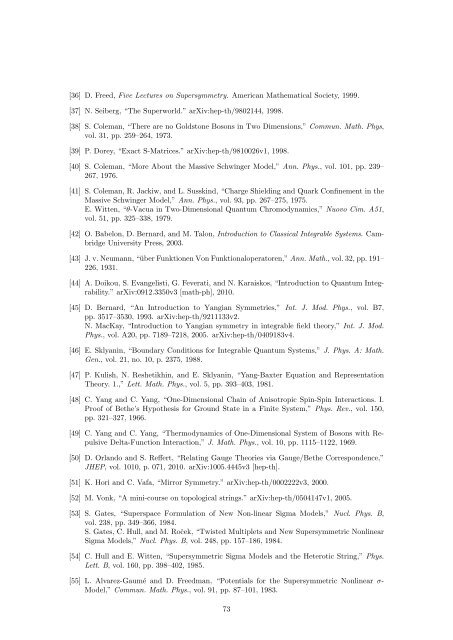The Bethe/Gauge Correspondence
The Bethe/Gauge Correspondence
The Bethe/Gauge Correspondence
Create successful ePaper yourself
Turn your PDF publications into a flip-book with our unique Google optimized e-Paper software.
[36] D. Freed, Five Lectures on Supersymmetry. American Mathematical Society, 1999.[37] N. Seiberg, “<strong>The</strong> Superworld.” arXiv:hep-th/9802144, 1998.[38] S. Coleman, “<strong>The</strong>re are no Goldstone Bosons in Two Dimensions,” Commun. Math. Phys,vol. 31, pp. 259–264, 1973.[39] P. Dorey, “Exact S-Matrices.” arXiv:hep-th/9810026v1, 1998.[40] S. Coleman, “More About the Massive Schwinger Model,” Ann. Phys., vol. 101, pp. 239–267, 1976.[41] S. Coleman, R. Jackiw, and L. Susskind, “Charge Shielding and Quark Confinement in theMassive Schwinger Model,” Ann. Phys., vol. 93, pp. 267–275, 1975.E. Witten, “θ-Vacua in Two-Dimensional Quantum Chromodynamics,” Nuovo Cim. A51,vol. 51, pp. 325–338, 1979.[42] O. Babelon, D. Bernard, and M. Talon, Introduction to Classical Integrable Systems. CambridgeUniversity Press, 2003.[43] J. v. Neumann, “über Funktionen Von Funktionaloperatoren,” Ann. Math., vol. 32, pp. 191–226, 1931.[44] A. Doikou, S. Evangelisti, G. Feverati, and N. Karaiskos, “Introduction to Quantum Integrability.”arXiv:0912.3350v3 [math-ph], 2010.[45] D. Bernard, “An Introduction to Yangian Symmetries,” Int. J. Mod. Phys., vol. B7,pp. 3517–3530, 1993. arXiv:hep-th/9211133v2.N. MacKay, “Introduction to Yangian symmetry in integrable field theory,” Int. J. Mod.Phys., vol. A20, pp. 7189–7218, 2005. arXiv:hep-th/0409183v4.[46] E. Sklyanin, “Boundary Conditions for Integrable Quantum Systems,” J. Phys. A: Math.Gen., vol. 21, no. 10, p. 2375, 1988.[47] P. Kulish, N. Reshetikhin, and E. Sklyanin, “Yang-Baxter Equation and Representation<strong>The</strong>ory. 1.,” Lett. Math. Phys., vol. 5, pp. 393–403, 1981.[48] C. Yang and C. Yang, “One-Dimensional Chain of Anisotropic Spin-Spin Interactions. I.Proof of <strong>Bethe</strong>’s Hypothesis for Ground State in a Finite System,” Phys. Rev., vol. 150,pp. 321–327, 1966.[49] C. Yang and C. Yang, “<strong>The</strong>rmodynamics of One-Dimensional System of Bosons with RepulsiveDelta-Function Interaction,” J. Math. Phys., vol. 10, pp. 1115–1122, 1969.[50] D. Orlando and S. Reffert, “Relating <strong>Gauge</strong> <strong>The</strong>ories via <strong>Gauge</strong>/<strong>Bethe</strong> <strong>Correspondence</strong>,”JHEP, vol. 1010, p. 071, 2010. arXiv:1005.4445v3 [hep-th].[51] K. Hori and C. Vafa, “Mirror Symmetry.” arXiv:hep-th/0002222v3, 2000.[52] M. Vonk, “A mini-course on topological strings.” arXiv:hep-th/0504147v1, 2005.[53] S. Gates, “Superspace Formulation of New Non-linear Sigma Models,” Nucl. Phys. B,vol. 238, pp. 349–366, 1984.S. Gates, C. Hull, and M. Roček, “Twisted Multiplets and New Supersymmetric NonlinearSigma Models,” Nucl. Phys. B, vol. 248, pp. 157–186, 1984.[54] C. Hull and E. Witten, “Supersymmetric Sigma Models and the Heterotic String,” Phys.Lett. B, vol. 160, pp. 398–402, 1985.[55] L. Alvarez-Gaumé and D. Freedman, “Potentials for the Supersymmetric Nonlinear σ-Model,” Commun. Math. Phys., vol. 91, pp. 87–101, 1983.73
















